Thanks to Bong Austero for that nice write-up about the blog in his column Are We There Yet? (30 August 2006). Here are excerpts from his column:
There are hundreds of thousands of blogs out there. There are blogs that entertain; some intentionally, others purely by accident. There are blogs that educate; some deliberately, others through vicarious and accidental learning. There are blogs that advocate certain causes. And then there are blogs that are able to do all three and more. I have been meaning to write about some of them mainly because of the causes they spouse.
Ivan Henares’s blog (www.ivanhenares.blogspot.com) is one blog that truly deserves to get more traffic. Ivan’s blog is a travel and heritage journal (the blog’s title is “Ivan About Town”) as it documents his many sojourns across the country and other parts of the world. I do not know Ivan personally so I do not know if he is as frisky; but in a way, he is like the local Ian Wright of Lonely Planet sans the television camera. Ian has television, Ivan has the blogosphere. Ivan goes to places and shares the experiences in his blog; he even gives details such as how much a jeepney ride from this point to that point, or how much lodging or dinner costs in this or that place.
But Ivan’s main advocacy is preservation of Philippine heritage. And this is what makes his blog truly worth supporting. His current advocacy is preservation of old churches, which are systematically being demolished to give way to some local parish priests’ demented attempt to establish their “legacy” in their parishes. The extent to which such aspirations of greatness translate into destroying centuries-old churches is already alarming.
Wednesday, August 30, 2006
Monday, August 28, 2006
Surigao del Norte: Maradjao karadjao Surigao!
Here is another those trips from my archives. I attended an annual convention of the Association of Tourism Officers of the Philippines (ATOP) in Surigao City in October 2003. Since there are no direct flights to Surigao, I had to fly to Butuan City first. From the airport, we were met by the organizers who had a ready vehicle for us to Surigao City, the capital of Surigao del Norte, which was two hours away.
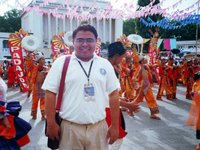 For the first two days, I had to endure the boring part which was the convention proper filled with speeches, lectures and keynote addresses! Hehe! But I was able to venture around the downtown area late in the afternoon when sessions were over. They have an American colonial period city hall in front of what is known as Luneta Park. Some of the better features of the park is a large sundial and pre-war acacia trees bordering the plaza.
For the first two days, I had to endure the boring part which was the convention proper filled with speeches, lectures and keynote addresses! Hehe! But I was able to venture around the downtown area late in the afternoon when sessions were over. They have an American colonial period city hall in front of what is known as Luneta Park. Some of the better features of the park is a large sundial and pre-war acacia trees bordering the plaza.
As part of the convention, there was also a showcase of ethnic Mamanwa-inspired dances from Surigao's Bonok-Bonok Maradjao Karadjao Festival in the grounds of the Surigao Provincial Capitol, another elegant colonial building.
 On the last day, they took us around the city and one of the places we visited was the Mabua Pebble Beach. The beach, which is about 30 minutes from the town proper, is most known for its kilometer-long stretch of fine round stones, native huts set in a natural backdrop of coconut tree-laden hills. We arrived just in time for its famous dramatic sunset.
On the last day, they took us around the city and one of the places we visited was the Mabua Pebble Beach. The beach, which is about 30 minutes from the town proper, is most known for its kilometer-long stretch of fine round stones, native huts set in a natural backdrop of coconut tree-laden hills. We arrived just in time for its famous dramatic sunset.
If only I had more time, I would have joined the trip to Siargao Island the next day. But I had decided to move my return flight to Manila from Butuan to Cagayan de Oro in order to explore more of Mindanao.
So the next day, I took the bus back to Butuan City, the capital of Agusan del Norte, where I stayed for a night at the relaxing Almont Inland Resort thanks to promo rates for Cebu Pacific passengers. Among the places I visited was the Butuan National Museum, the "repository of historical and cultural materials and artifacts that proves Butuan’s prehistoric existence and rich cultural heritage."
One place I missed, and its such a shame that I did, was the Balangay Shrine Museum which is the attraction Butuan in most known for. The balangays of Butuan were declared national cultural treasures. I even bought myself a really nice miniature balangay to take home for display.
The next day, before leaving for Cagayan de Oro, I made a trip to the local market to look out for more cultural souvenirs. I was quite happy to find a shop selling different kinds of local salakots. And I bought several of them for my collection. After lunch, the hotel service took me to the bus station for my three hour trip to Cagayan de Oro, the capital of Misamis Oriental.
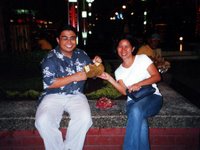 In CDO, my SSEAYP batchmate MJ picked me up at the station. The plan was for us to visit the Gardens of Malasag Eco-Tourism Village. But it was raining really hard when I arrived so we weren't able to do much. We met up with another batchmate Andy later in the evening and had dinner at the outdoor ihawans and food stalls along Magsaysay Avenue. But I was lucky since it was fruit season and I got to savor a Mindanao fruit which many of us in Luzon do not know about. I had one whole marang fruit all to myself! Hehe! Yummy!
In CDO, my SSEAYP batchmate MJ picked me up at the station. The plan was for us to visit the Gardens of Malasag Eco-Tourism Village. But it was raining really hard when I arrived so we weren't able to do much. We met up with another batchmate Andy later in the evening and had dinner at the outdoor ihawans and food stalls along Magsaysay Avenue. But I was lucky since it was fruit season and I got to savor a Mindanao fruit which many of us in Luzon do not know about. I had one whole marang fruit all to myself! Hehe! Yummy!
My flight back to Manila was the next morning so I was not able to really do much. Again it was such a quick trip and I was not as adventurous then as I am now. Hehe! I'll hopefully be back in Cagayan de Oro this September en route to Camiguin.
 For the first two days, I had to endure the boring part which was the convention proper filled with speeches, lectures and keynote addresses! Hehe! But I was able to venture around the downtown area late in the afternoon when sessions were over. They have an American colonial period city hall in front of what is known as Luneta Park. Some of the better features of the park is a large sundial and pre-war acacia trees bordering the plaza.
For the first two days, I had to endure the boring part which was the convention proper filled with speeches, lectures and keynote addresses! Hehe! But I was able to venture around the downtown area late in the afternoon when sessions were over. They have an American colonial period city hall in front of what is known as Luneta Park. Some of the better features of the park is a large sundial and pre-war acacia trees bordering the plaza.As part of the convention, there was also a showcase of ethnic Mamanwa-inspired dances from Surigao's Bonok-Bonok Maradjao Karadjao Festival in the grounds of the Surigao Provincial Capitol, another elegant colonial building.
 On the last day, they took us around the city and one of the places we visited was the Mabua Pebble Beach. The beach, which is about 30 minutes from the town proper, is most known for its kilometer-long stretch of fine round stones, native huts set in a natural backdrop of coconut tree-laden hills. We arrived just in time for its famous dramatic sunset.
On the last day, they took us around the city and one of the places we visited was the Mabua Pebble Beach. The beach, which is about 30 minutes from the town proper, is most known for its kilometer-long stretch of fine round stones, native huts set in a natural backdrop of coconut tree-laden hills. We arrived just in time for its famous dramatic sunset.If only I had more time, I would have joined the trip to Siargao Island the next day. But I had decided to move my return flight to Manila from Butuan to Cagayan de Oro in order to explore more of Mindanao.
So the next day, I took the bus back to Butuan City, the capital of Agusan del Norte, where I stayed for a night at the relaxing Almont Inland Resort thanks to promo rates for Cebu Pacific passengers. Among the places I visited was the Butuan National Museum, the "repository of historical and cultural materials and artifacts that proves Butuan’s prehistoric existence and rich cultural heritage."
One place I missed, and its such a shame that I did, was the Balangay Shrine Museum which is the attraction Butuan in most known for. The balangays of Butuan were declared national cultural treasures. I even bought myself a really nice miniature balangay to take home for display.
The next day, before leaving for Cagayan de Oro, I made a trip to the local market to look out for more cultural souvenirs. I was quite happy to find a shop selling different kinds of local salakots. And I bought several of them for my collection. After lunch, the hotel service took me to the bus station for my three hour trip to Cagayan de Oro, the capital of Misamis Oriental.
 In CDO, my SSEAYP batchmate MJ picked me up at the station. The plan was for us to visit the Gardens of Malasag Eco-Tourism Village. But it was raining really hard when I arrived so we weren't able to do much. We met up with another batchmate Andy later in the evening and had dinner at the outdoor ihawans and food stalls along Magsaysay Avenue. But I was lucky since it was fruit season and I got to savor a Mindanao fruit which many of us in Luzon do not know about. I had one whole marang fruit all to myself! Hehe! Yummy!
In CDO, my SSEAYP batchmate MJ picked me up at the station. The plan was for us to visit the Gardens of Malasag Eco-Tourism Village. But it was raining really hard when I arrived so we weren't able to do much. We met up with another batchmate Andy later in the evening and had dinner at the outdoor ihawans and food stalls along Magsaysay Avenue. But I was lucky since it was fruit season and I got to savor a Mindanao fruit which many of us in Luzon do not know about. I had one whole marang fruit all to myself! Hehe! Yummy!My flight back to Manila was the next morning so I was not able to really do much. Again it was such a quick trip and I was not as adventurous then as I am now. Hehe! I'll hopefully be back in Cagayan de Oro this September en route to Camiguin.
Friday, August 25, 2006
Vietnam: Hoi An town and the story of my backpack
 It was this trip to Hoi An, another UNESCO World Heritage Site, which opened my eyes to the backpacking culture. In 2003, I was introduced to bus travel between countries when I took a bus from Singapore to Kuala Lumpur to visit friends. From Kuala Lumpur, I took a six hour bus up north to Malaysia’s heritage jewel, the city of Georgetown in Penang. But I had always traveled with a large piece of luggage and it was difficult for me to move around. The first thing I would do when I arrived in a place was to look for a hotel and drop off my luggage before I could go around. The Hoi An trip changed that.
It was this trip to Hoi An, another UNESCO World Heritage Site, which opened my eyes to the backpacking culture. In 2003, I was introduced to bus travel between countries when I took a bus from Singapore to Kuala Lumpur to visit friends. From Kuala Lumpur, I took a six hour bus up north to Malaysia’s heritage jewel, the city of Georgetown in Penang. But I had always traveled with a large piece of luggage and it was difficult for me to move around. The first thing I would do when I arrived in a place was to look for a hotel and drop off my luggage before I could go around. The Hoi An trip changed that.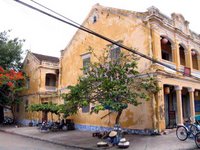 According to UNESCO, Hoi An “is an exceptionally well-preserved example of a South-East Asian trading port dating from the 15th to the 19th century. Its buildings and its street plan reflect the influences, both indigenous and foreign, that have combined to produce this unique heritage site.”
According to UNESCO, Hoi An “is an exceptionally well-preserved example of a South-East Asian trading port dating from the 15th to the 19th century. Its buildings and its street plan reflect the influences, both indigenous and foreign, that have combined to produce this unique heritage site.”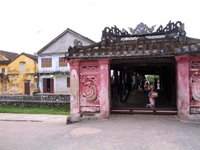 I purchased my bus ticket at an agency in front of our hotel. I was happy that I only spent US$6 for a round trip ticket. The attendant was so surprised that my return ticket was on the same day because tourists who purchased tickets from them usually bought a one-way ticket since their next stop after that would be Ho Chi Minh or they would stay overnight and come back the next day. Imagine catching the first six hour trip down to Hoi An, staying for only two hours, and taking the last bus back to Hue. It’s like commuting to Baguio and coming back down just after two hours of sight-seeing. But unlike Baguio, Hoi An was just a small town and two hours was enough to see the sights but not quite enough to experience the culture. But I was pressed for time so I had no choice.
I purchased my bus ticket at an agency in front of our hotel. I was happy that I only spent US$6 for a round trip ticket. The attendant was so surprised that my return ticket was on the same day because tourists who purchased tickets from them usually bought a one-way ticket since their next stop after that would be Ho Chi Minh or they would stay overnight and come back the next day. Imagine catching the first six hour trip down to Hoi An, staying for only two hours, and taking the last bus back to Hue. It’s like commuting to Baguio and coming back down just after two hours of sight-seeing. But unlike Baguio, Hoi An was just a small town and two hours was enough to see the sights but not quite enough to experience the culture. But I was pressed for time so I had no choice.On the wall were other destinations in Vietnam and the rest of Indochina. It was then that I realized that I could tour Southeast Asia via bus. And it was that realization in 2004 which led to my three-week five-country journey around Southeast Asia last April. I remember e-mailing people about the idea and buying a map of Indochina in Hue to try to plan the trip. And thus, after two years of yearning and planning, the trip finally pushed through.
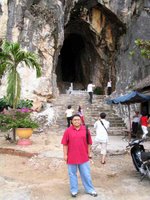 One of the added attractions of this bus trip were stopovers at other tourist attractions on the way including this place called Marble Mountain. When we arrived there, there was shop after shop of marble souvenirs in all known colors of marble. Unlike those some of those cheap-looking marble souvenirs we have in Romblon (the marble in Romblon is high quality and the souvenirs are carved from whole marble and not molded marble dust and resin like the ones here but there's something about the carvings I don't like, especially the letterings they put which make them look cheap), the shops here had so many quality items to choose from such as animal figures, small busts of Ho Chi Minh and Chairman Mao, Buddha heads and other religious images as well as larger marble items. And the prices were shockingly cheap! I remember buying a 10-inch high brown marble Buddha head for something like PHP300. To make the long story short, I bought more than I could carry and realized that I would be lifting this box of marble stuff as I went around Hoi An.
One of the added attractions of this bus trip were stopovers at other tourist attractions on the way including this place called Marble Mountain. When we arrived there, there was shop after shop of marble souvenirs in all known colors of marble. Unlike those some of those cheap-looking marble souvenirs we have in Romblon (the marble in Romblon is high quality and the souvenirs are carved from whole marble and not molded marble dust and resin like the ones here but there's something about the carvings I don't like, especially the letterings they put which make them look cheap), the shops here had so many quality items to choose from such as animal figures, small busts of Ho Chi Minh and Chairman Mao, Buddha heads and other religious images as well as larger marble items. And the prices were shockingly cheap! I remember buying a 10-inch high brown marble Buddha head for something like PHP300. To make the long story short, I bought more than I could carry and realized that I would be lifting this box of marble stuff as I went around Hoi An.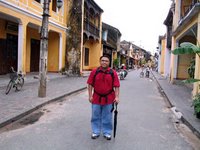 I never intended to buy myself a backpack but I ended up having to do so out of necessity. Yup, the first thing I did when I arrived in Hoi An was to buy a backpack that could carry all the items I bought. And I didn’t have to search far since there were so many shops which sold bags due to the fact that Hoi An was a popular stop in the Southeast Asian backpack trail. When I finally found a backpack which could hold the entire box, it was off for a walk around the old town to check out the sites.
I never intended to buy myself a backpack but I ended up having to do so out of necessity. Yup, the first thing I did when I arrived in Hoi An was to buy a backpack that could carry all the items I bought. And I didn’t have to search far since there were so many shops which sold bags due to the fact that Hoi An was a popular stop in the Southeast Asian backpack trail. When I finally found a backpack which could hold the entire box, it was off for a walk around the old town to check out the sites.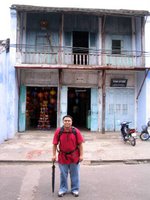 So that's how I got my backpack and started bakpacking! Hehe! Anyway, I was reading Wikipedia and found this brief history of Hoi An: "The former harbour town of the Champa people at the estuary of the Thu Bon river was an important trading centre in the 16th and 17th centuries, where Chinese from various provinces as well as Japanese, Dutch and Indians settled down. During this period of the China trade, the town was called Hai Pho (Seaside Town), during the French occupation. Originally Hai Pho was a divided town, because across the "Japanese Bridge" used to be the Japanese settlement. The bridge (Chùa cầu) is a unique covered structure built by the Japanese, the only known covered bridge with a Buddhist pagoda attached to one side."
So that's how I got my backpack and started bakpacking! Hehe! Anyway, I was reading Wikipedia and found this brief history of Hoi An: "The former harbour town of the Champa people at the estuary of the Thu Bon river was an important trading centre in the 16th and 17th centuries, where Chinese from various provinces as well as Japanese, Dutch and Indians settled down. During this period of the China trade, the town was called Hai Pho (Seaside Town), during the French occupation. Originally Hai Pho was a divided town, because across the "Japanese Bridge" used to be the Japanese settlement. The bridge (Chùa cầu) is a unique covered structure built by the Japanese, the only known covered bridge with a Buddhist pagoda attached to one side."I also found this website which has a nice photo of the port area. You can check out my photos in Hoi An here.
Subscribe to:
Posts (Atom)
